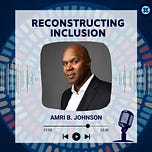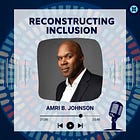Welcome to the Reconstructing Inclusion Podcast!
As the conversation around diversity, equity, and inclusion continues to evolve, we stand at a pivotal juncture. The pendulum of public sentiment continues to swing wildly between what some call "wokery" and combustible "anti-DEI" sentiments. But what if this binary thinking is precisely what's holding us back from creating truly inclusive environments? Intuitively, this makes sense. Most of us know such binaries are silly and unproductive. Yet, we continue to box ourselves in, anchored on our rightness, transforming, “Absolutely Nothing! Say it Again Ya’ll!”
Drawing on conversations with past guests and my own experience in the field, I want to share a perspective that transcends the polarizing debates that have dominated the DEI landscape since 2020.
The boxes that were called for in 2020 around DEI are different than the boxes we see today, but not as much as you might think. The dynamics between the so-called DEI proponents and the anti-DEI crowd are different, yet quite similar. They're polar extremes, but they're still extremes, and extremes of either pole oftentimes resemble one another.
This realization invites us to step back and consider: What happens when we move beyond these artificial boundaries? How might our organizations and communities transform if we focused less on categorizing people and more on creating conditions where everyone can thrive?
My exploration of three types of boxes provides a framework for understanding how identity politics shapes our interactions and institutions. More importantly, it offers a roadmap for breaking free from these constraints to build more genuine and effective approaches to inclusion.
The Three Boxes That Define Our Identity Politics
Let’s consider the idea that our identities are shaped by three distinct types of "boxes":
The way I see it, there are three types of boxes. Boxes that are ascribed to us. Boxes that are conscribed, meaning we're constricted or we're forced into them. And boxes we subscribe to. [00:02:00]
These boxes fundamentally shape how we see ourselves and others, often without our conscious awareness. This framing can serve as a convenient metaphor to steer us away from any attachments we have to reductionist notions of identity and toward more purposeful and relational ways of seeing, being, and doing with the so-called other.
I found this concept powerfully illustrated during a conversation with Professor Subrena Smith of the University of New Hampshire, who once told me:
Race can be ascribed to me, but I will not subscribe to it. [00:02:30]
Race has been ascribed to her because of her skin color, but Subrena doesn't ascribe to that identity. Instead, she subscribes to being a Jamaican woman who happens to have a darker skin color. This distinction between how others categorize us and how we choose to identify ourselves reveals the profound difference between external labels and multidimensional identity—a reminder of personal agency in the face of social categorization.
Sometimes, though, the line between choice and coercion blurs:
We subscribe to certain boxes, but sometimes it's not really a subscription. It's acquiescence. Or in a way, conscription. We're concerned that if we don't subscribe, we don't belong. [00:03:00]
This reality challenges us to examine which aspects of our identities are freely chosen versus those accepted out of social necessity or fear of exclusion. How much of who we claim to be stems from authentic connection rather than the pressure to conform? The answer has profound implications for how we approach inclusion work.
The Precarious Binary of Anti-Racist vs. Not Racist
One of the most influential frameworks in recent DEI discourse has been the binary of "anti-racist" versus "not racist" popularized by author Ibram X. Kendi. The anti-racist v. racist one is quite daft, so I won’t even address it, but the idea of being “not racist” being a step below the anti-racist heroes might be even sillier because it’s a linguistic slight of hand. Jason Reynolds, co-author of "Stamped: Racism, Antiracism, and You," used a baseball analogy that I find particularly revealing:
He explained the difference between not racist and racist... He said, not racist is like going for a bunt in baseball. You hold the bat out hoping the ball hits it. You're not expecting to hit hard. You just connect so you can make a play. Being anti-racist, he contrasts, is swinging the bat as hard as you can for a home run. [00:06:30]
This analogy has shaped much of our current discourse, but there's a fundamental problem with it:
The problem with this analogy is beyond the fact that it's just incomplete. The reality is, if you know baseball, bunts are strategic. When done skillfully, they can help a team win as much as a home run can. Home runs don't automatically win games. Especially in anti-racism. [00:07:00]
Many of the dramatic "home runs" in DEI, anti-racist, and social justice spaces since 2020 didn't win games. In fact, they created the opposite effect—spurring others to try winning a similar game in a completely different direction. Rather than rejecting anti-racism entirely, we need a more sophisticated, strategic understanding of how change happens. Progress on inclusion requires diverse approaches and tactics—not just dramatic gestures but thoughtful, contextual responses.
Extending the baseball metaphor:
Inside the batter’s box, you can move in, up, out, left, right. You can put your foot on the line. And you can use that positioning to do what you want to do to help your team meet the needs of the moment. . .The goal is determining what helps you help your team win, whether it's a bunt, an opposite field hit or a fielder's choice. A sacrifice fly, anything that drives in a key run. [00:08:30]
The Shifting Tides of DEI Discourse
The current political climate has brought a concerning shift in how DEI is discussed and implemented:
The current political tides are leading us in what I consider a pretty untenable direction. It's similar to where we started in 2020 between the pandemic and George Floyd. And in this case, I believe it's emerging alongside a type of cold and compassionless norming. [00:10:50]
Before, there was at least an attempt to be compassionate. Now, on the extreme end of the anti-DEI spectrum, compassion seems absent. It's all about winning and being right—which ironically mirrors the problematic dynamics of the most extreme DEI advocates in 2020.
The parallels between the "woke" period post-2020 and the current anti-DEI backlash reveal a troubling pattern:
There was self censoring then and now self censoring is happening in a different way for different reasons. Everybody has resurrected their first amendment rights, but in a way that is at least concerning to me, because the current state feels different. It's accompanied by a harsh, or harsher, vengeful energy. [00:13:30]
What's particularly alarming is the perception that powerful institutions are normalizing uncivil engagement. As Adam Grant would say, "think again"—if you don't believe this dynamic could affect your organization, you're likely underestimating the pervasiveness of these cultural forces.
Moving Beyond Boxes
For organizations charting their course these complex waters, I offer this guidance:
If you're going to have anything resembling boxes, make sure you create one that's for everyone. Incorporate your company mission, expectations, and requirements for behavior. I'm not talking about niceness. I'm not a big fan of overly nice workplaces. [00:15:00]
To illustrate this point, I once worked with a company that prided itself on being "FM Nice":
We'd be in a meeting and people would be like, yeah, this great, super leave the meeting. ‘Oh, I don't know what they were talking about. They don't get it. I don't know what's wrong with them.’ So there was a lot of niceness, but there wasn't a lot of intellectual honesty. [00:15:45]
There wasn't space to disagree with each other or recognize interdependence with colleagues—even while badmouthing them behind their backs. This wasn't acceptable then, and it isn't now.
Instead of superficial niceness, what we need is something much more substantial:
I believe in kindness. I believe in respect, respectfulness, civility, dignity, and clarity about interdependence in your teams and organization. I believe these things are the beginning of your requirements. [00:16:00]
If you don't want anti-DEI sentiment to create a space where a small segment of extreme views dominates your organizational discourse, you need clear requirements. And those with the most influence must signal these values regularly.
The correction to problematic DEI discourse isn't to swing to the opposite extreme:
The opposite overcorrecting is not going to help the tired old DEI discourse, more so it will move toward people feeling like they're sanctioned to be cruel, to be cold hearted, to be disrespectful and to make people feel like they don't deserve dignity—it is not helpful. It is not a real correction. [00:17:10]
Everybody deserves dignity regardless of their political leanings. We all deserve it, and your organization should expect it. If dignity isn't being honored, swift correction is necessary.
My final reflection brings us full circle:
Get clear about the box that all of us sit in. And at some point, you'll realize there never was a box. It's all in our heads. Those principles that I talked about before are in our heads, too. Principles of kindness. Respectfulness, civility, dignity, clarity, all a part of the inclusion conversation. [00:18:00]
We're all interdependent. There's no going it alone in organizational life.
Key Takeaways
Identity is shaped by three types of boxes: Those ascribed to us by others, those we're conscribed or forced into, and those we genuinely subscribe to. Understanding these distinctions helps us navigate identity with greater agency and authenticity.
Binary thinking undermines effective inclusion work. Both extreme "woke" and "anti-DEI" positions create rigid boxes that limit human potential and connection. Effective inclusion requires nuanced approaches that acknowledge complexity.
Strategic, context-appropriate responses beat ideological purity. Like in baseball, sometimes a well-placed bunt achieves more than swinging for the fences. Effective inclusion work requires tactical flexibility and situational awareness.
We're experiencing a dangerous pendulum swing in public discourse. The harsh energy of some anti-DEI rhetoric mirrors the problematic aspects of earlier DEI extremes. Both undermine genuine inclusion.
Universal principles transcend political divisions. Values like dignity, respect, and interdependence provide common ground for collaborative work across differences.
Intellectual honesty matters more than superficial niceness. The ability to disagree productively is essential for inclusive cultures—far more valuable than performative pleasantries.
The boxes that divide us exist primarily in our minds. By challenging these mental constructs, we can begin to see our fundamental interconnectedness and build more authentic inclusive communities.
Resources:
Reconstructing Inclusion S1E6: What is Race Abolition?: Illuminating Racialization’s Complexity with Dr. Subrena Smith and Dr. David Livingstone Smith
"Stamped: Racism, Antiracism, and You" - Book co-authored by Jason Reynolds and Ibram X. Kendi that explores the history of racist ideas in America.
Peter Senge's Definition of Leadership - "Leadership is the capacity for a human community to shape its future."
Join our free EMERGENT Inclusion Framework virtual event. This isn't another discussion about group identities, allyship, and injustice. While those things have their place, the focus on symptoms rather than diving into the complexity of systems have not unlocked organizational value as practitioners and supporters have hoped for them to. Whether you're a skeptic or champion, your voice matters in this conversation.














Share this post